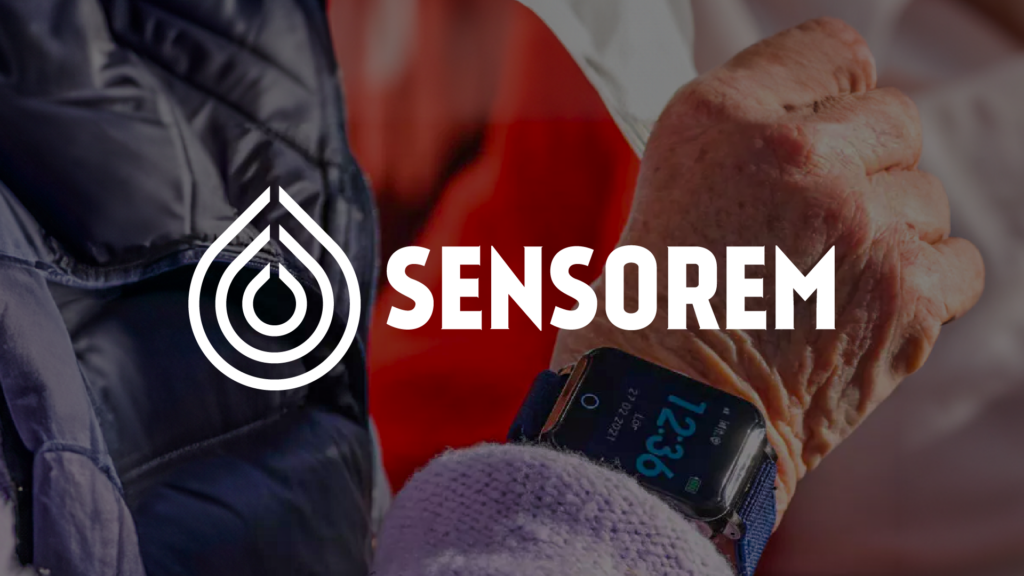Get the Sensorem case study sent directly to your inbox
Sensorem is on a mission to save lives. The Swedish startup cares about one of the most vulnerable groups of our society – elderly people – by offering a safety alarm that works everywhere and increases freedom for the user.
Its main function is very simple yet important at the same time. If the button is pressed, the watch places a call to the relatives of the person wearing the bracelet, so that when something happens, that person can alert their caretakers. Of course, there are other functions: there’s geofencing, if you need it, there’s a reminder for taking pills, there’s the option to trigger an alert if the watch isn’t moving, and more.
Sensorem offers the alarm and the services that go with it on a subscription basis. As long as the customer is subscribed, Sensorem will take care of everything related to the device and its functions, ranging from offering a 24/7 alarm central that processes calls that relatives didn’t pick up, to replacing the watch if anything happens to it.
The distribution model partially defines how Sensorem gets its customers: most of them come from Sensorem’s own website, and they discover it mostly thanks to advertising campaigns in Google and Facebook.
The Challenge: High Traffic Doesn’t Mean Good Conversions
There are two ways one can approach Google and Facebook campaigns. One is to pour in money and hope to get more traffic and more sales. The other is to try and optimize your spend, understanding your customers better and providing them with a tailored experience.
Sensorem chose the second way, and in the very beginning learned that their conversion rate (CR) of about 1% was way below average. And there were two main reasons for that:
- Campaign traffic quality. More traffic doesn’t necessarily mean more sales. The cheap traffic they were acquiring was poorly qualified.
- Lack of website conversion rate optimization. Ideally, every eCommerce website should be optimized for the target audience. Following a list of general best practices gets you halfway to your goal. But for further optimization, you need to really understand your buyer and optimize your store specifically for them.
At that point, Sensorem’s co-founder and COO Johan Danielsson realized that they needed to start putting their efforts into conversion-rate optimization (CRO). A CRO agency offered their services, but they were too expensive for a small startup. And so, Johan and the team decided to do everything on their own.
The Solution: Optimizing Traffic Quality and Website
The decision to do everything in-house made Johan look for a CRO tool, and he wanted to find the best one. At first, he used Hotjar, but was dissatisfied with its functionality: Hotjar offered a lot of data, but it wasn’t clear what to do with it. So, after some more searching and comparing, he settled on Mouseflow (by the way, here’s how Hotjar compares to Mouseflow).

The onboarding process with Mouseflow was really good. I’m not a programmer myself, so I appreciate it a lot when customer support and success teams break down what you can do on your own, and what you need to assign to developers.
After installing Mouseflow on Sensorem’s website and looking at the user behavior data, Johan and the team got a lot more information about their website that they could use to improve it. That allowed them to find bottlenecks – and eliminate them.
- After realizing that a lot of people drop out during the checkout process, they completely revamped the checkout, simplifying the flow for the users.
- By watching recordings with high friction score, they were able to find and fix a previously uncaught, but naughty bug that prevented visitors from converting.
- They evaluated each campaign and determined its quality based on how the visitors behaved on the website. It turned out that visitors coming from cheaper cost-per-click campaigns usually didn’t leave the main landing page, and barely even scrolled through it. So, they abandoned these campaigns, focusing their efforts on more expensive, but better qualified traffic.
- Relying on the data from Mouseflow’s website heatmap tool, they’ve optimized the website to streamline the user journey.
The Result: 2x Conversion Rate Improvement
Optimizing campaigns and improving user experience always pays off. In Sensorem’s case, the payoff was doubling conversion rate over the span of 6 months, with CR reaching ≈ 2%.
This was the result of two most important parts:
- Optimizing the campaigns, bringing more interested users to the website.
- Improving the overall website experience, tailoring it better to the target audience – elderly people – and removing friction points along their way.
Sensorem continues to use Mouseflow, now that they are shaping the marketing strategy to go beyond Swedish borders. That requires a deep understanding of how different audiences interact with their website, and Mouseflow is their go-to tool for these insights. New audiences mean new requirements – and new challenges. But Johan is very optimistic about the future.

Our current customers are really happy with Sensorem and we are doing great financially. So, our main focus now is scaling. With data and insights from Mouseflow, I believe that we would be able to run successful campaigns internationally and expand our presence.
Company: Sensorem AB
Tools used: Mouseflow, Ahrefs, Mailchimp
CMS: WordPress + WooCommerce
Features used in Mouseflow: Heatmaps, Session Replay, Dashboards, Friction Score
